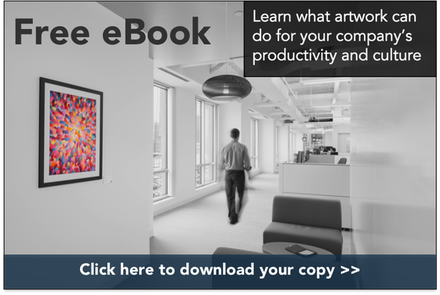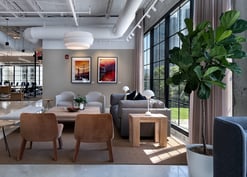The Millennial generation makes up over a third of today’s workforce, and the U.S. Bureau of Labor Statistics estimates that by 2020 they will account for nearly half of it. Research around this tech-savvy, highly connected generation reveals that their attitudes and expectations around work fundamentally differ from preceding generations and, consequently, have shifted the way companies manage and engage with their employees. As a result, operational changes and new management practices are informing the way commercial interior designers and facilities managers create office spaces and choose office artwork.
American furniture designer and creative innovator, Charles Eames asserted that the quality of a design is directly related to the quality of its connections between people, ideas, and objects. In order to build high quality connections between office spaces and the people using them, it’s essential for us to understand the values of the millennial generation, and how this emerging majority’s values manifest in the workplace.
Millennials were the first generation to be raised using the Internet, which has made a profound impact on the attitude with which they approach information and learning. As a study on maximizing Millennials in the workplace from the UNC Kenan-Flagler School of Business points out, the web's free, instantaneous flow of data has shifted the role of elder generations from information gatekeepers to experienced insight-providers and mentors. The study also finds that Millennials prefer involved and hands-on leadership over the traditional command and control style of previous generations. With a redefined attitude towards legacy and authority, the working relationship between managers and employees is shifting towards a more horizontal structure.
Millennial interest in democratizing office structure is imbued in more general workplace expectations as well: they seek unstructured flows of information, opportunities for personal enrichment, flexibility, and collaboration to meet their potential. The UNC study notes that Millennials constitute our most educated and diverse generation yet, which has shaped them into goal-oriented and socially conscious workers who value meaningful work above factors including high income, responsibility, and a sense of accomplishment.
Despite this influx of disruptions to the workplace status quo, the objective of office designers remains the same: facilitate productivity. The effects of Millennial culture only manifest in the designer’s means to achieve their objective. At first glance, “facilitating productivity” might sound grim and spartan, but research indicates productivity is directly linked to employee well-being. The days of forcibly engaging employees by isolating them in cubicles are over; instead, companies are discovering that organically engaging employees through encouraging social interaction and investing in perks and benefits yield more high-quality work.
Returning to Eames’s philosophy on quality through connection, companies should approach their offices as physical manifestations of their company culture and values. For example, by forgoing over-sized C-suite offices in favor of open floor plans and flexible workstations, the office space itself can reinforce a culture of seeking hands-on leadership, collaboration, and open flow.
To successfully engage Millennials, it's time to let go of the traditional corporate aesthetic around walled offices, generic artwork, and permanent high-end furnishings. To build genuine and lasting connections between employees and their workspace, companies should look to design to express their values, such as encouraging collaboration through furniture layout, appealing to social consciousness by integrating environmentally-friendly initiatives, and investing in employee well-being through outlets such as game rooms and stocked kitchens.
With employee and office lease turnovers occurring more often than ever, it's also imperative to design around flexibility and adaptability to achieve longevity. Furniture rental, art rental, plant services, and periodic changes to color schemes are essential details in making a timeless, well-connected design. In fact, according to a recent study by Gensler, a global design consultancy, 72% of employees at companies that are doing this see their company as being more innovative and having a leadership that cares about fostering innovation, versus 40% at companies that don’t. Millennials are attracted to innovative companies and those that are successful in fostering connections and recognizing employee well-being as an investment will gain the unprecedented ambition of the Millennial workforce.
If you’d like to learn more about how you can foster an innovative culture through design, take a look at our eBook by clicking the button below!

.jpg?width=332&height=177&name=_MG_0840%20copy%20(2).jpg)

.jpg?width=332&height=177&name=dtBv_067_DSC_2139_DaNil%20(2).jpg)



